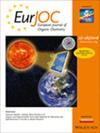萜烯和萜类:我们如何使用它们?
IF 2.7
3区 化学
Q2 CHEMISTRY, ORGANIC
引用次数: 0
摘要
在过去的几十年里,化学过程中使用的原料受到了极大的关注,这主要是由于2004年Werpy报告的生物质高附加值化学品清单的普及。传统的以化石为基础的原料既消耗殆尽,又会对环境造成破坏。这导致了以更多可再生的生物基平台化学品取代石油基化学品的热潮。萜烯和萜类化合物是一类众所周知的生物基化合物。然而,对这些化合物的化学用途的全面概述很少。在这里,我们提供了一个完整的综合概述与萜烯的化学报道,同时特别强调其反应性。本文讨论了15种最常见和最有用的单萜烯和萜类化合物,然后列出了属于该类的剩余已知化合物的清单。这15种化合物已被广泛应用于不同的化学转化,包括:聚合、全合成、手性试剂/助剂、药物和化学转化为其他有用的生物基化学品。我们相信,在这项工作中提出的化学将为化学家提供一个有用的工具,应该促进和刺激寻找更可持续,可再生和环境友好的新合成路线的起点。本文章由计算机程序翻译,如有差异,请以英文原文为准。
Terpenes and Terpenoids: How can we use them?
As one of the twelve fundamental principles of green chemistry, the employed feedstocks in chemical processes received substantial attention over the past decades. These efforts can be attributed to Werpy's 2004 list of top‐value‐added chemicals from biomass. Conventional fossil‐based feedstocks are both depleting and environmentally damaging, leading to the transition towards renewable, bio‐based platform chemicals. Terpenes and terpenoids are a group of bio‐based compounds well known throughout the scientific community. Although their acquirement from natural feedstocks is well known, comprehensive overviews of their applications in synthetic chemistry remain limited. Herein, a full comprehensive overview of the reported chemistry with terpenes is provided, while specifically highlighting their reactivity. Fifteen of the most common and useful monoterpenes and terpenoids are discussed, followed by a list of the remaining known compounds belonging to this group. These fifteen compounds have been employed in a vast number of chemical transformations with different applications including: polymerizations, total syntheses, chiral reagents/auxiliaries, pharmaceuticals, and chemical conversion to other useful bio‐based chemicals. The presented chemistry in this work aims to provide chemists with a useful tool that should facilitate and stimulate the search for more sustainable, renewable, and environmentally friendly starting points for novel synthesis routes.
求助全文
通过发布文献求助,成功后即可免费获取论文全文。
去求助
来源期刊
CiteScore
5.40
自引率
3.60%
发文量
752
审稿时长
1 months
期刊介绍:
The European Journal of Organic Chemistry (2019 ISI Impact Factor 2.889) publishes Full Papers, Communications, and Minireviews from the entire spectrum of synthetic organic, bioorganic and physical-organic chemistry. It is published on behalf of Chemistry Europe, an association of 16 European chemical societies.
The following journals have been merged to form two leading journals, the European Journal of Organic Chemistry and the European Journal of Inorganic Chemistry:
Liebigs Annalen
Bulletin des Sociétés Chimiques Belges
Bulletin de la Société Chimique de France
Gazzetta Chimica Italiana
Recueil des Travaux Chimiques des Pays-Bas
Anales de Química
Chimika Chronika
Revista Portuguesa de Química
ACH—Models in Chemistry
Polish Journal of Chemistry.

 求助内容:
求助内容: 应助结果提醒方式:
应助结果提醒方式:


